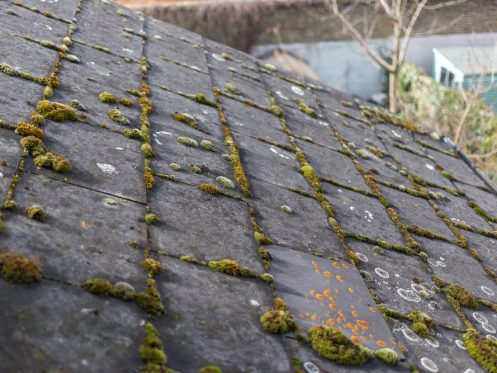Mold is one of the most troubling things that a homeowner can ever face. Not only does it look awful, but it can also pose a serious health risk to you and your family. Mold tends to grow in places where there is trapped moisture, and it can spread quickly. Because your roof is frequently exposed to wind and rain, it’s more at risk of experiencing mold growth. It’s a serious problem that every roofing contractor works to prevent whenever they install a new roof. It’s a living organism that will spread through your home, and its rapid spread can be difficult to manage. It can also damage different areas of your home, which can make it look less appealing.
Many types of mold are toxic and can cause health problems (such as dizziness, short attention spans, and memory loss). Mold spores can also be an allergen for many people, which may cause serious and even life-threatening reactions. In serious cases, heavy exposure to mold spores can lead to asthma attacks. The worst thing about mold is that it can spread quickly throughout your home. Because the spores are so small, they can move between pieces of siding, shingles, and other areas you may not expect.
Signs You Have Mold on Your Roof
A quality roofing contractor will know all about the dangers of mold and will do whatever is needed to make sure it doesn’t spread throughout your roof. There’s still a chance that it can get into your home, even after the professionals have finished installing your roof. This can lead to a variety of issues, which is why you need to understand the signs of a mold infestation before it becomes a serious problem.
Here are some of the common signs of a mold infestation on your roof:
- Leaking Roof — If you have leaks throughout your home, there’s a good chance it has been infested with mold. While leaks aren’t caused by mold, the conditions caused by them can give it an opportunity to grow.
- Roof Damage — Roofers will use different building tricks and materials to make sure your roof stays as strong as possible, but wind and other storm conditions can pull shingles out by their nails or cause different types of damage. This can put your home in a difficult situation and can give mold easy access to your roof as well as the rest of your home, especially if you let it go for long periods of time.
- Nasty Odors in Your Home — Mold can produce a nasty smell that many people have noticed at some point in their lives. Think about the smell in antique shops and used bookstores. That musty odor is a sign of mold growth, even if you can’t see it. And if you can smell it the higher up you go, there’s a good chance your roof is the cause.
- Visible Mold in Your Home — Many people may not know what mold looks like, and they may think it’s just dust or dirt staining their walls. Mold can come in many different colors (including gray, brown, green, white, and black). If you see any visible signs of mold in your home, you could be in a difficult situation. This is especially true if you see more of it when you move further up in your home and see mold growth in your attic.
By the time you see mold spreading downward from your roof to the rest of your home, you will most likely start to experience symptoms. You may have allergic reactions and attacks that will make it hard for you to breathe. You may even have itchy skin and fevers if you’re directly exposed to mold spores. These issues will only get worse, especially if your home has problems with too much moisture or condensation.
Preventing Mold or Growth on Your Roof
Aside from regular cleanings and routine roof maintenance, there’s more you can do to prevent mold growth on your roof. Some of them include, but may not be limited to:
- Trimming Tree Branches — You can allow more sunlight to get to your roof by trimming back tree branches. The more it’s exposed to, the less opportunity mold will have to grow.
- Clearing Debris — You can remove debris from your roof with a leaf blower or by some other non-abrasive method. Wet leaves and debris that sit on your roof for long periods of time can be a potential breeding ground for mold.
- Cleaning Your Gutters — Keeping your gutters running efficiently is an important part of roof maintenance because it will keep water from backing up onto your roof or stagnating in one spot.
- Upgrading Your Shingles — You can install algae-resistant asphalt shingles, or you can add strips made of zinc or copper so you can keep algae and moss from growing on your roof.
If you’re looking for one of the best roofers in Corpus Christi, be sure to get in touch with Bayfront Roofing.
